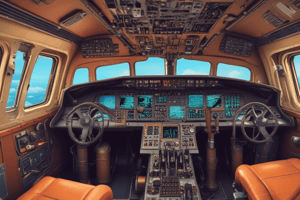Podcast
Questions and Answers
What is the main reason for selecting manual mode in the cabin pressurisation system?
What is the main reason for selecting manual mode in the cabin pressurisation system?
- To operate the system automatically
- To carry out high altitude parachute drops or in case of a malfunction in the automatic pressurisation controller (correct)
- To increase the vacuum pressure
- To decrease the cabin air pressure
What regulates the vacuum pressure in manual mode?
What regulates the vacuum pressure in manual mode?
- The outflow valve
- The pressurisation control panel
- The auto/manual control valve
- The rate control knob (correct)
What is the function of the outflow valve in manual mode?
What is the function of the outflow valve in manual mode?
- To control the discharge rate of the pressurised air (correct)
- To regulate the vacuum pressure
- To operate the safety valve
- To control the cabin altitude
What is the result of rapidly operating the manual rate control valve with the aircraft pressurised?
What is the result of rapidly operating the manual rate control valve with the aircraft pressurised?
What is the function of the safety valve?
What is the function of the safety valve?
What is monitored by the aircrew during manual operation?
What is monitored by the aircrew during manual operation?
What component is NOT part of an electronic cabin pressurisation system?
What component is NOT part of an electronic cabin pressurisation system?
What is the purpose of the pressurisation control panel in an electronic cabin pressurisation system?
What is the purpose of the pressurisation control panel in an electronic cabin pressurisation system?
What is the primary function of the Cabin Pressure Controller?
What is the primary function of the Cabin Pressure Controller?
What is the purpose of the FLT/GND switch?
What is the purpose of the FLT/GND switch?
What input serves as a backup to the FLT/GND switch?
What input serves as a backup to the FLT/GND switch?
What happens when the Manual AC or Manual DC is selected on the mode selector?
What happens when the Manual AC or Manual DC is selected on the mode selector?
What is the purpose of the valve position indicator?
What is the purpose of the valve position indicator?
What is the function of the Close/Off/Open toggle switch?
What is the function of the Close/Off/Open toggle switch?
In which mode of operation is the cabin pressure control similar to the mechanical (pneumatic) cabin pressure controller?
In which mode of operation is the cabin pressure control similar to the mechanical (pneumatic) cabin pressure controller?
What is the primary difference between the automatic mode and the manual mode?
What is the primary difference between the automatic mode and the manual mode?
What is the primary purpose of the differential control range?
What is the primary purpose of the differential control range?
At what altitude does the isobaric range typically end?
At what altitude does the isobaric range typically end?
What is the name of the valve that opens to maintain maximum pressure at approximately 22,000 ft?
What is the name of the valve that opens to maintain maximum pressure at approximately 22,000 ft?
What is the pressure differential experienced by the aircraft at 41,000 ft cruise altitude?
What is the pressure differential experienced by the aircraft at 41,000 ft cruise altitude?
What is the purpose of the rate/unpressurised range?
What is the purpose of the rate/unpressurised range?
What is the name of the range where the cabin maintains a constant pressure or cabin altitude as the flight altitude changes?
What is the name of the range where the cabin maintains a constant pressure or cabin altitude as the flight altitude changes?
What is the maximum cabin altitude of a typical jet transport aircraft?
What is the maximum cabin altitude of a typical jet transport aircraft?
What is the primary function of the outflow valve?
What is the primary function of the outflow valve?
What does the cabin altimeter display?
What does the cabin altimeter display?
What is the unit of measurement displayed on the cabin rate of climb indicator?
What is the unit of measurement displayed on the cabin rate of climb indicator?
What is the purpose of the cabin rate of climb indicator?
What is the purpose of the cabin rate of climb indicator?
How does the cabin rate of climb indicator sense cabin pressure?
How does the cabin rate of climb indicator sense cabin pressure?
What is the range of the cabin rate of climb indicator?
What is the range of the cabin rate of climb indicator?
What happens to the pressure inside the capsule when the cabin pressure decreases?
What happens to the pressure inside the capsule when the cabin pressure decreases?
What is the function of the restrictor in the cabin rate of climb indicator?
What is the function of the restrictor in the cabin rate of climb indicator?
What is the effect of the pressure difference on the capsule in the cabin rate of climb indicator?
What is the effect of the pressure difference on the capsule in the cabin rate of climb indicator?
What is the primary purpose of the pressure reducing valve in the supply inflated seal system?
What is the primary purpose of the pressure reducing valve in the supply inflated seal system?
What is the purpose of tapping off air pressure from the main supply line?
What is the purpose of tapping off air pressure from the main supply line?
What should be inspected frequently in inflatable rubber seals?
What should be inspected frequently in inflatable rubber seals?
What is the effect of poor sealing on the pressurisation system?
What is the effect of poor sealing on the pressurisation system?
What is the difference between self-inflation seals and supply inflated seals?
What is the difference between self-inflation seals and supply inflated seals?
What is the purpose of the cabin sealing system?
What is the purpose of the cabin sealing system?
What happens to the air pressure in a supply inflated seal during inflation?
What happens to the air pressure in a supply inflated seal during inflation?
Why is good sealing important in the pressurisation system?
Why is good sealing important in the pressurisation system?
Flashcards are hidden until you start studying
Study Notes
Cabin Pressurisation Ranges
- The rate/unpressurised range maintains a gradual increase or decrease in cabin pressure until the desired cabin altitude is reached.
- The isobaric range is defined as the range of cabin pressurisation in which the cabin maintains a constant pressure or cabin altitude as the flight altitude changes.
- The differential control range is defined as the altitude range where a constant differential pressure is maintained between the cabin pressure and the atmospheric pressure as the aircraft climbs or descends.
Manual Operation
- Manual mode can be selected by the aircrew to operate the system manually in case of a malfunction in the automatic pressurisation controller.
- Manual mode is selected by placing the auto/manual control valve to the MANUAL position.
- During manual operation, the aircrew continuously monitor the pressurisation indications for cabin altitude, differential pressure, and rate of change.
Electronic Cabin Pressurisation System
- An electronic cabin pressurisation control system has the following components: pressurisation control panel, cabin pressure controller, and electrically operated outflow valve.
- Automatic mode will smoothly control the cabin from before take-off to after landing with little or no further input from the crew.
Cabin Pressure Indicators
- The cabin altimeter and differential pressure indicator displays cabin altitude above sea level and the pressure difference between cabin and ambient pressures.
- The cabin rate of climb indicator displays the rate at which the cabin pressure is increasing (descending) or decreasing (climbing), in Feet per Minute (FPM).
Cabin Sealing
- There are two basic methods of sealing aircraft canopies and doors: self-inflation seals and supply-inflated seals.
- Self-inflation seals use the existing cabin pressure to inflate the seals during pressurisation.
- Supply-inflated seals require an independent supply of air for their inflation.
Operational Tests and Precautions
- The efficiency of pressurisation is dependent on good sealing of the pressure vessel within the aircraft.
- Inflating rubber seals require frequent inspection for cuts, badly scuffed areas, foreign objects trapped in the channels, and security of attachment to the airframe structure.
Studying That Suits You
Use AI to generate personalized quizzes and flashcards to suit your learning preferences.



